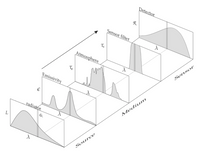Compute the radiative flux transferred from a 2.5 m2 polished aluminum plate at 1000 K to a camera that has a 2 inches optical aperture (objective diameter) and a silicon CMOS focal plane array (about 1 cm2), located 10 m away from the plate. Assume that the plate is a Lambertian radiator and all light entering the camera aperture reaches the detector array. Use Figure 1 as a guide for your calculations. Assume that the lens is completely transparent at all wavelengths, the sensor filter is a bandpass filter that completely blocks all small wavelengths up to UV and long wavelengths beyond 1 THz. In the passing band the filter is perfectly transparent. The emissivity of polished aluminum and transmittance of the atmosphere can be considered constant over the entire spectrum (search for the approximate values online – cite the used reference).

Trending nowThis is a popular solution!
Step by stepSolved in 2 steps

- Please I want a correct and clear solution to this question. The solution must be clear and handwritten. Course name: Lasers and its Applications 412PHYSarrow_forwardFor a light of wavelength 589 nm, calculate the critical angles for the following substances when surrounded by water? glycerine= fluorite= sodium chloride=arrow_forwardPlease I want a correct and clear solution to this question. The solution must be clear and handwritten. Course name: Lasers and its Applications 412PHYSarrow_forward
- 1.2) In a region of gas where the optical depth is 2.0, what percentage of photons can escape without being scattered or absorbed?arrow_forwardThese images show one of the large `VLT’ telescopes at the European Southern Observatory’s facility at Cerro Paranal, Chile. The place where the laser beam comes out (seen in the inset photo) is just out of sight off of the top edge of the large photo. Also note that if you look down the telescope tube (in the main photo), you can see the tube’s front-end structure. Imagine that this telescope had a flaw similar to the Hubble Space Telescope’s - its light-gathering element was shaped wrong. What problem would this cause for the telescope? Group of answer choices It would not be able to bring rays of light from a distant object to a focus. The imperfect shape would mean that it could focus rays of visible light, but not rays of light of any other wavelength. It wouldn’t be able to gather much light compared to the pupil of a human eye. It would mean that the telescope could only work if placed above the Earth’s atmosphere, like the Hubble telescope.arrow_forward